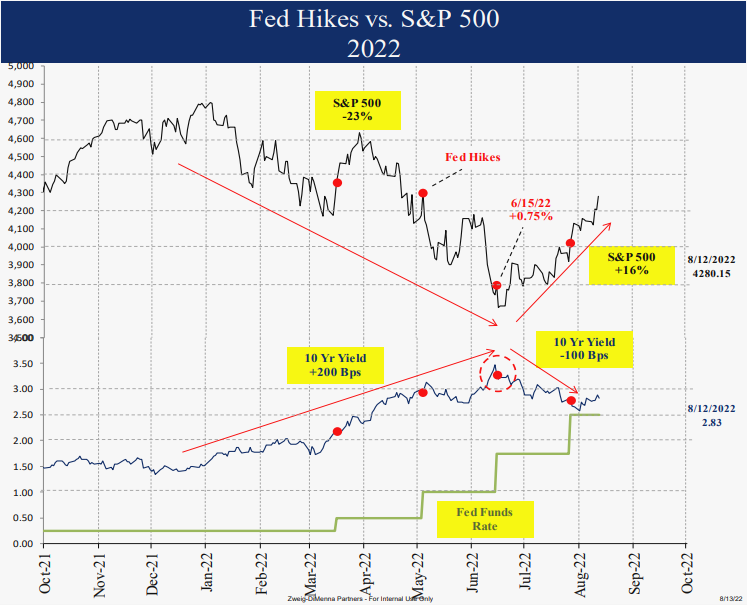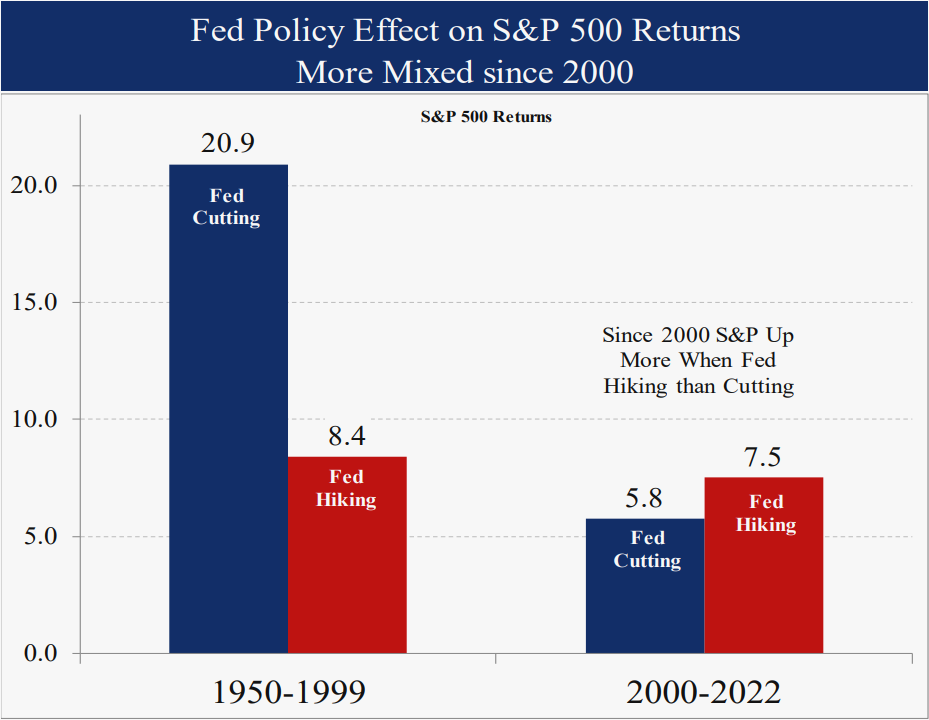Doom and Gloom Consensus is an Opportunity
Investing Environment Review and Outlook – Volume 63
Doom and Gloom Consensus is an Opportunity
Last month we discussed the likely consolidation for equities after such a strong upside move and overbought market. Since the 8/17/22 peak the S&P 500 did more than consolidate, declining sharply by 10% and reversing 2/3s of the rally since June. The 9/13/22 upside CPI inflation surprise reversed the “peak inflation” consensus from July. Now most see a doom loop where the U.S. has a substantial underlying inflation problem which will require much higher interest rates, which, in turn, will lead to a more severe equity bear market and an imminent recession. As this new view was factored in, yields moved higher across the curve, and equities responded to the downside as they did in the first half. Higher interest rates compress multiples.
This month we discuss an alternative view of the facts starting with inflation, and more importantly, the significant implications for equities through year end. Conditions such as commodity prices, the economy, investor positioning, and seasonality today are quite different from the first half.
We reduced emerging markets to a 4 rating due to the persistently strong U.S. dollar. U.S. and foreign-developed equities remain a neutral 3. Long term bonds are a neutral 3. Gold remains a bullish 5 and commodities are a neutral 3.
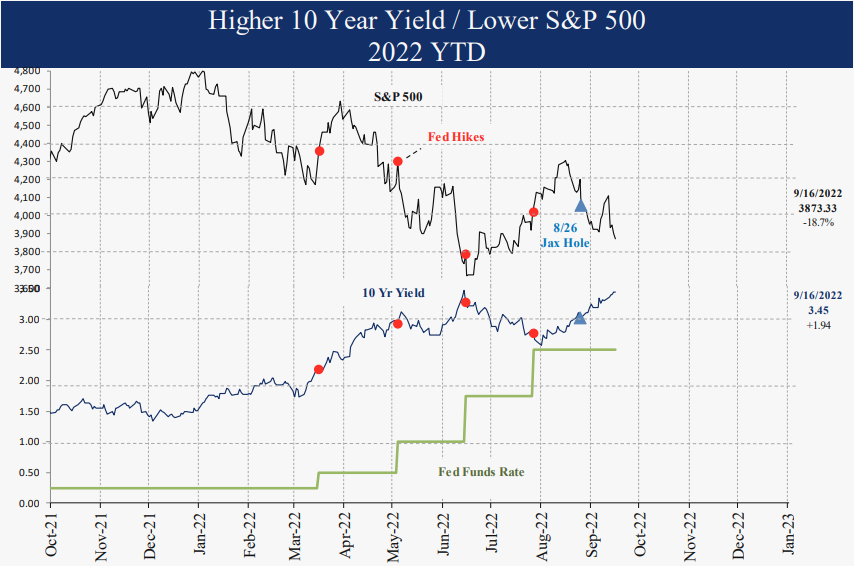
CPI Inflation Trend: Bullish for Equities
Despite the lower August headline CPI inflation released on 9/13/22 (8.3% vs. 8.5%), the higher core figure, not including food or energy (6.3% vs. 5.9%) was seen as evidence of further upside ahead for inflation. Aside from the fact that the core figure is a lagging number, due to the housing component, there is significant evidence that overall inflation by any measure will continue lower. This trend lower is meaningful, since historically the direction of inflation was predictive of equity returns. Perhaps surprising, since 1970, the S&P 500 returned 12.8% annualized while CPI inflation was high (over 4%) and falling as it is now, even when the Fed was hiking rates. Whether inflation will settle back to 2% is certainly unknowable, but more importantly, not relevant for investors today. It is the trend that matters.
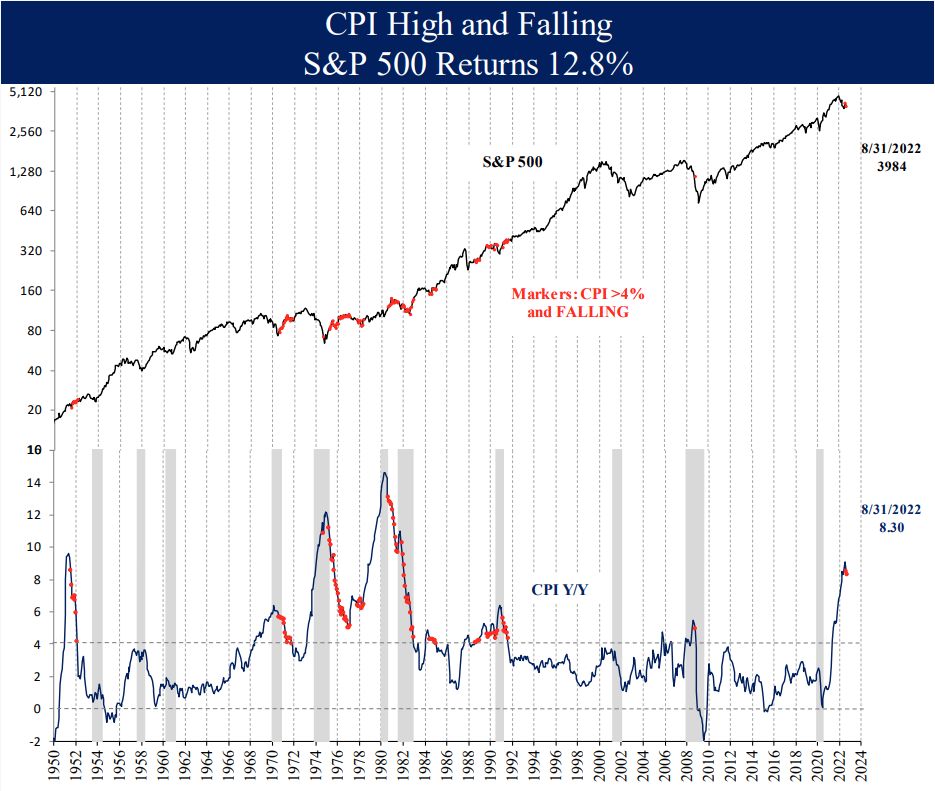
Lower Inflation Ahead: Supply and Demand
The 8.3% inflation today can be traced to three demand and supply shocks. First, the unexpectedly strong Covid rebound demand due to catch up purchases accelerated by record government stimulus spending. Second, the supply chain issues from labor shortages and overwhelming demand. And third, the Ukraine War cutting critical supplies of food and energy.
This year all three of these forces reversed. First, the COVID economic rebound is best illustrated by the ISM index reaching the 99th percentile at 64.7 in March 2021. Since then, the index declined to a neutral 52.8 as the economy slowed, easing the overheated demand on goods and services in a typical mid-cycle slowdown. There have been 10 similar mid-cycle slowdowns since 1950 that eased pressure on inflation and were not followed by a recession. Federal outlays are also down 16% from their 2021 peak, cutting macro demand.
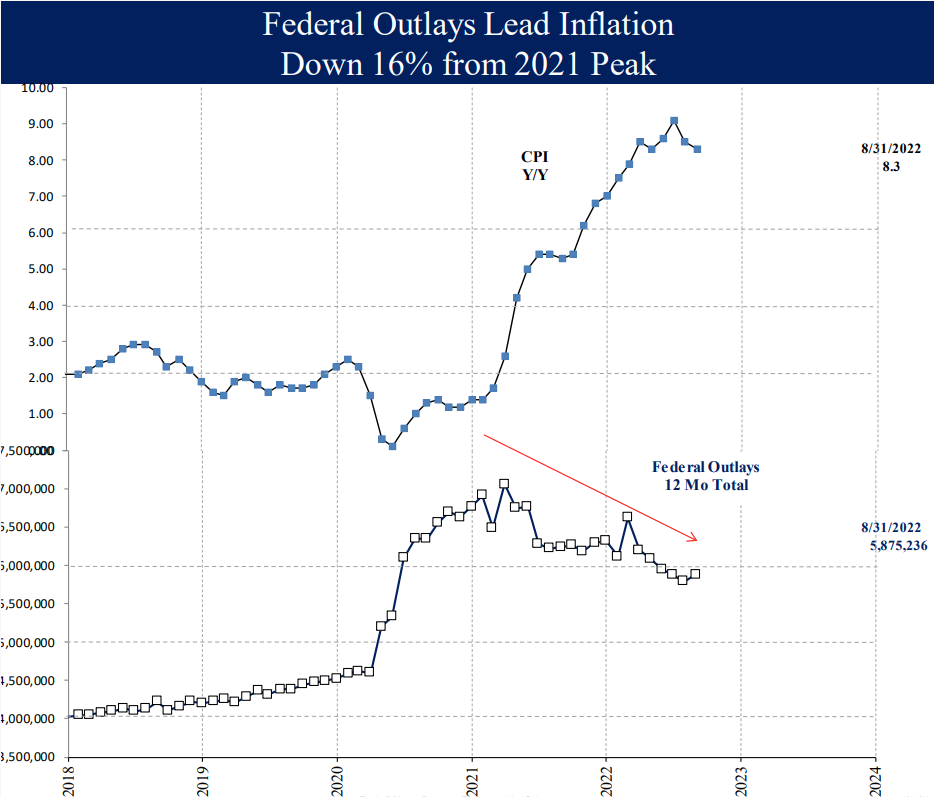
Supply Chain Running Again
Second was the supply chain issues, best illustrated by the ISM Deliveries index which hit a peak of 78 in 2021 and has since also declined to a neutral 55.1 today. This is one piece of evidence showing that supply chains are returning to normal, also easing pressure on prices.
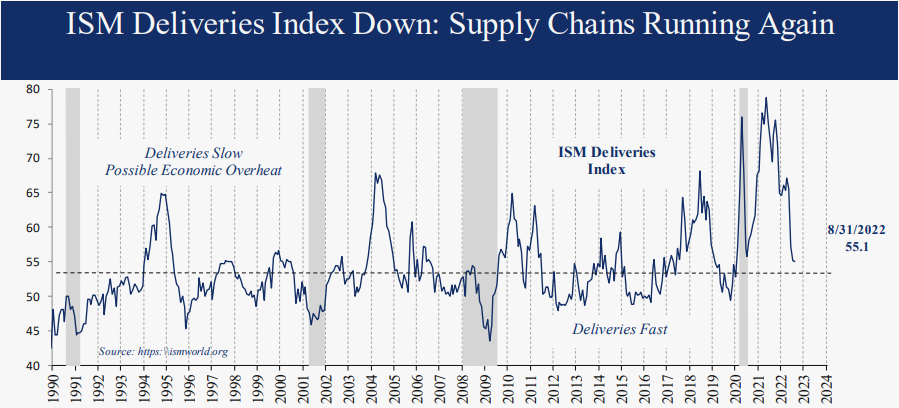
Ukraine Inflation Effects: Reversing
The third piece of high inflation was the Ukraine War. Partly as a result, U.S gasoline prices rose sharply to a peak of $5 per gallon in July, pushing the CPI inflation index to 9.1% Y/Y. Gasoline prices have since reversed 26% lower to $3.68, putting downward pressure on inflation. In addition, food prices as measured by the FAO Food Price Index rose to a peak of 40.0 in May 2021 but have since reversed to just 7.9 as of August. This is also a good leading indicator of inflationlike prior peaks in 2007 and 2010.
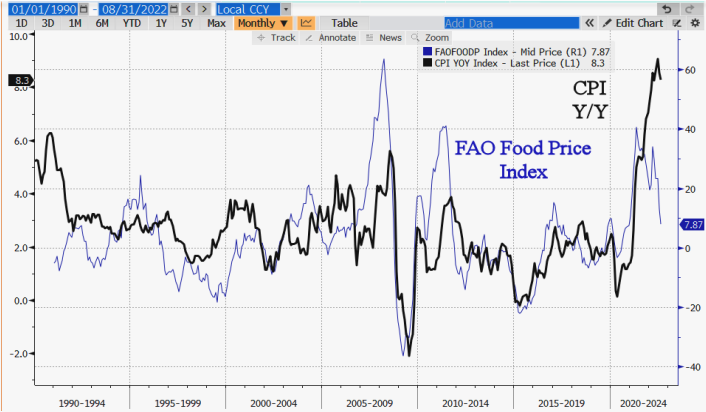
Europe Natural Gas Price Down 45%: Bullish
Finally, European natural gas prices more than tripled from June to August. The New York Times headline on 9/19/22 was “Crippling Energy Bills Force Europe’s Factories to Go Dark.” No question there is a devastating energy crisis in Europe. What is surprising and likely positive for inflation is the 45% decline in natural gas prices from the August peak. During the first Gulf War in 1990 the July Kuwait invasion also caused an oil price spike and an equity bear market. In that case the October oil peak at $40 marked the low in equities and the end of the war to come. Obviously, the geopolitical issues are complex and seemingly intractable, but the 1990 pattern may be comparable.
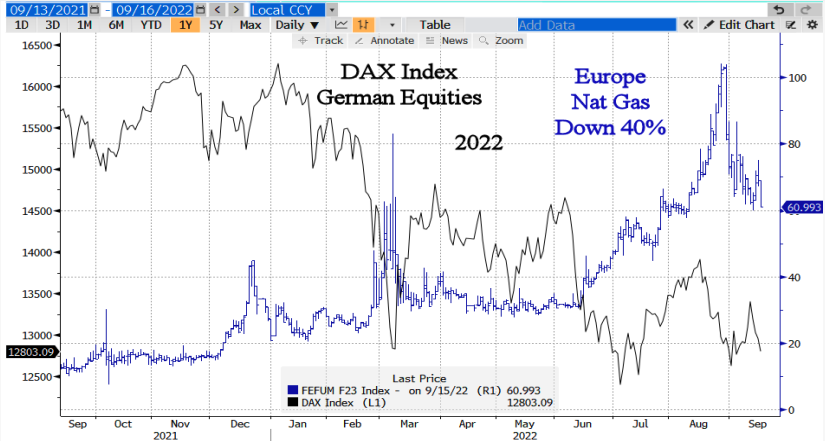
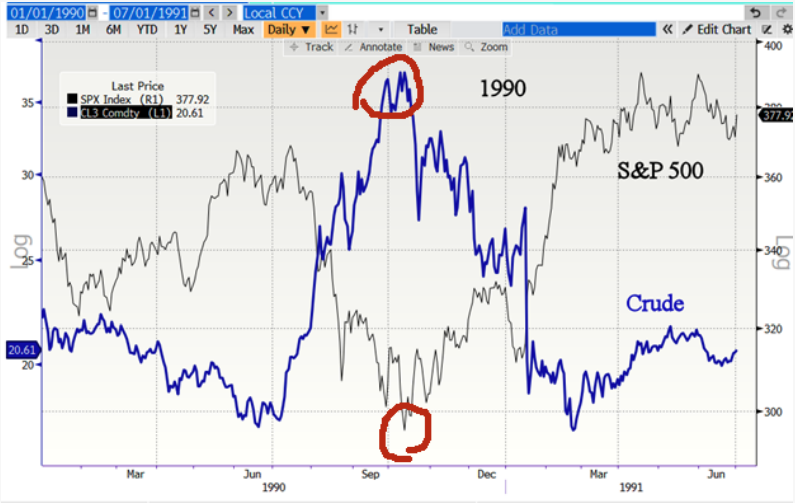
Investors Positioned for Doom and Gloom: Positive for Equities
From the daily negative headlines it is obvious most investors are bearish. Similar to the June low before the S&P rallied 16%, all 10 investor groups we track are positioned short, and 7 of 10 are in extreme positions. The Bank of America monthly survey run by Michael Hartnett is a great example. Institutional investors were record bearish in their September survey, even more so than at any time in 2008 during the Global Financial Crisis when the S&P 500 declined over 50% from the peak. This means cash on the sidelines to drive stocks higher. Like a dry forest, it is just a matter of time before a fire ignites.
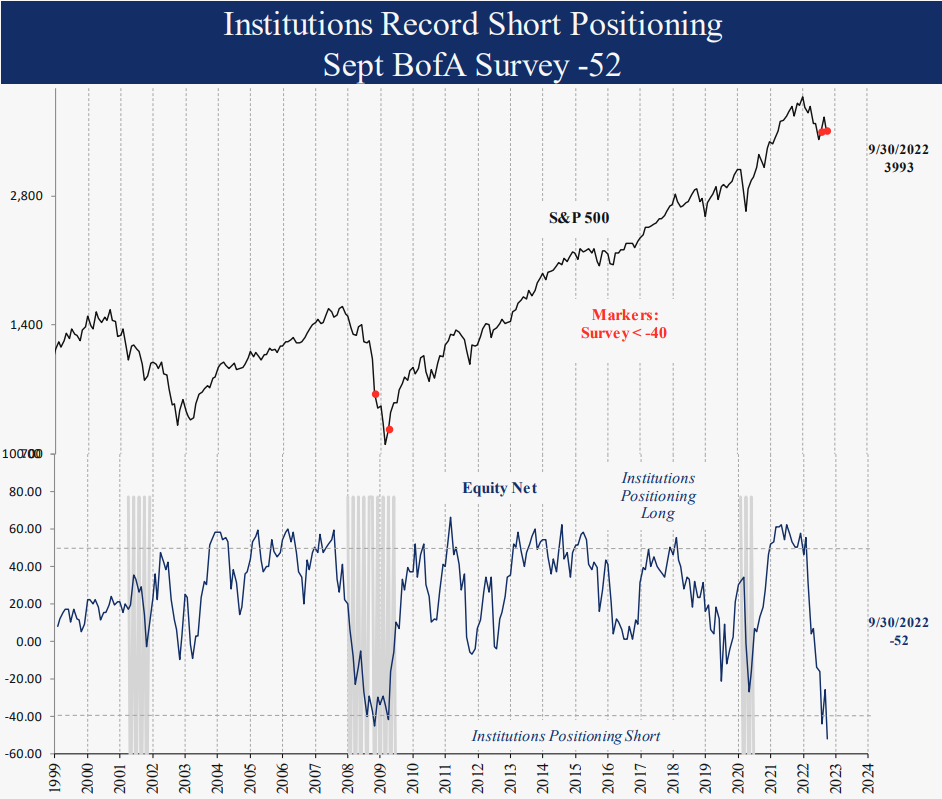
Q4 Equity Returns are Best of the Year
It is widely known that Q4 returns (October-December) are historically the best of the year. However, this year is particularly positive in the 2nd year of the Presidential Cycle (and mid-term elections), with a 7.6% average return since 1950, almost 2x other presidential cycle years and over 30% annualized. The first quarter of the third year of the presidential cycle (corresponding to next year – 2023 in the current cycle) historically is even better at 8.3%, the strongest quarter of the whole presidential cycle.
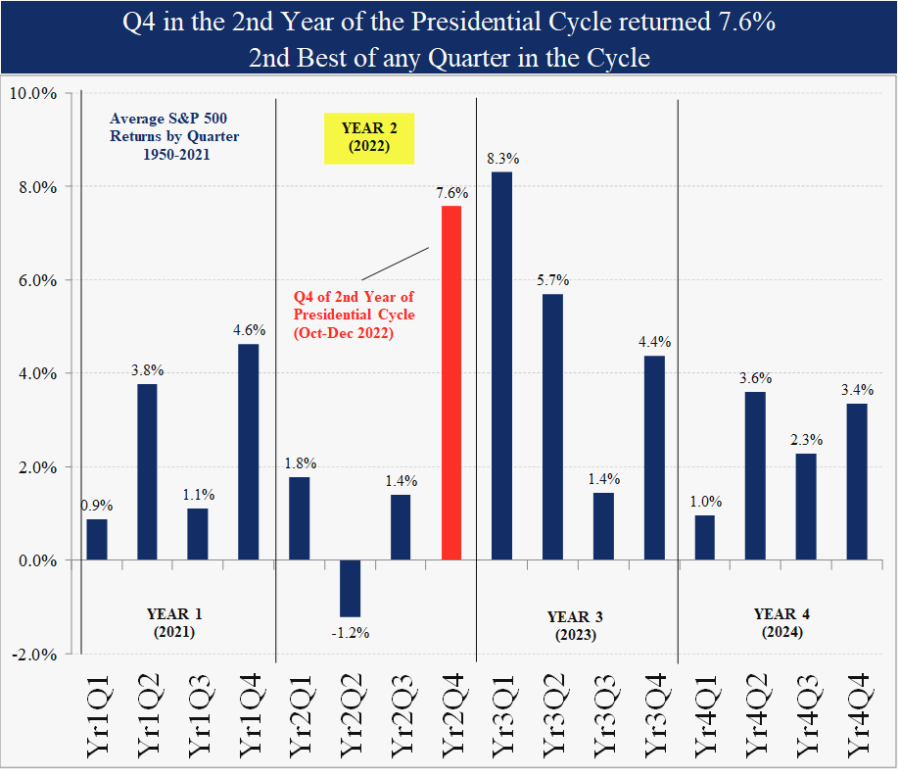
Summary
Seasonality remains negative through the end of September, but the combination of falling inflation, extreme investor positioning and positive Q4 seasonality marks a potential upside opportunity for a year-end move into 2023. The 40% decline in European natural gas bears watching. If it marks some sort of war resolution ahead, the implications would be significant – likely a dollar reversal, stronger commodities and a European focus shift from assured recession to a much more positive outlook to rebuild Ukraine and all the stimulus that would entail. We will continue to monitor our indicators on a daily basis and keep you posted. Thank you for your support and please contact us with any questions.
IMPORTANT DISCLOSURES
This review and outlook report (this “Report”) is for informational, illustration and discussion purposes only and is not intended to be, nor should it be construed as, financial, legal, tax or investment advice, of Brenton Point Wealth Advisors LLC or any of its affiliates (“Brenton Point”). This Report does not take into account the investment objectives, financial situation, restrictions, particular needs or financial, legal or tax situation of any particular person and should not be viewed as addressing any recipient’s particular investment needs. Recipients should consider the information contained in this Report as only a single factor in making an investment decision and should not rely solely on investment recommendations contained herein, if any, as a substitution for the exercise of independent judgment of the merits and risks of investments.
This material is based upon information obtained from various sources that Brenton Point believes to be reliable, but Brenton Point makes no representation or warranty with respect to the accuracy or completeness of such information. Views expressed herein are current only as of the date indicated and are subject to change without notice.
This Report contains certain forward looking statements opinions, estimates, projections, assessments and other views (collectively “Statements”). These Statements are subject to a number of assumptions, risks and uncertainties which may cause actual results, performance or achievements to be materially different from future results, performance or achievements expressed or implied by these forward looking statements and projections. Brenton Point makes no representations as to the reasonableness of such assumptions or the likelihood that such assumptions will coincide with actual events and this information should not be relied upon for that purpose. Changes in such assumptions could produce materially different results. Past performance is not a guarantee or indication of future results, and no representation or warranty, express or implied, is made regarding future performance of any financial instrument mentioned in this Report.
Any benchmark shown herein is shown for illustrative purposes only. No index benchmark is available for direct investment. It may not be possible to replicate the returns of any index, as the index may not include any trading commissions and costs or fees, may assume the reinvestment of income, and may have investment objectives, use trading strategies, or have other materials characteristics, such as credit exposure or volatility, that do not make it suitable for a particular person. This is not an offer or solicitation for the purchase or sale of any security, investment, or other product and should not be construed as such. References to specific financial instruments and to certain indices are for illustrative purposes only and provided for the purpose of making general market data available as a point of reference only; they are not intended to be, and should not be interpreted as recommendations to purchase or sell such securities. Investing in securities and other financial products entails certain risks, including the possible loss of the entire principal amount invested, as the value of investment can go down as well as up. You should obtain advice from your tax, financial, legal, and other advisors and only make investment decisions on the basis of your own objectives, experience, and resources.
Brenton Point accepts no liability for any loss (whether direct, indirect or consequential) occasioned to any person acting or refraining from action as a result of any material contained in or derived from this Report, except to the extent (but only to the extent) that such liability may not be waived, modified or limited under applicable law.
This Report may provide addresses of, or contain hyperlinks to, Internet websites. Brenton Point has not reviewed the linked Internet website of any third party and takes no responsibility for the contents thereof. Each such address or hyperlink is provided solely for your convenience and information, and the content of linked third party websites is not in any way incorporated herein. Recipients who choose to access such third-party websites or follow such hyperlinks do so at their own risk.
All marks referenced herein are the property of their respective owners. This Report is licensed for non-commercial use only, and may not be reproduced, distributed, forwarded, posted, published, transmitted, uploaded or otherwise made available to others for commercial purposes, including to individuals within an institution, without written authorization from Brenton Point.
Source of data and performance statistics: Bloomberg L.P. and Factset Research Systems Inc.
©Brenton Point Wealth Advisors LLC 2022

Michael Schaus
Director of Market Research
Michael Schaus is the Director of Market Research for Brenton Point Wealth Advisors and Zweig-DiMenna. Since joining Zweig-DiMenna in 1992, his focus has been on macroeconomic research, the analysis of…
READ MORERead Next:
Sign up!
Sign up for our monthly newsletter and get the lastest news and research from our esteemed advisors here at Brenton point. Right into your inbox!


 Client Login
Client Login

